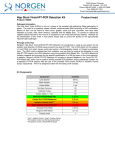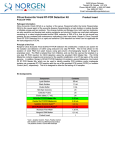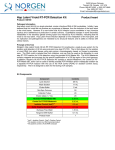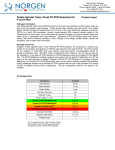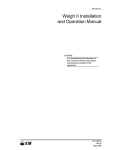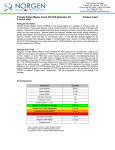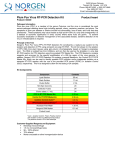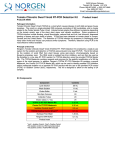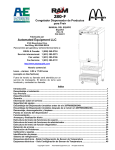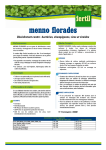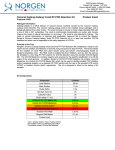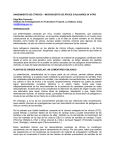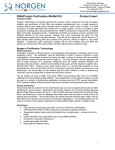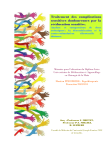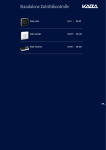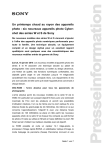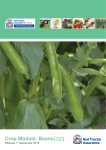Download Pospiviroid RT-PCR Detection Kit - Protocol
Transcript
3430 Schmon Parkway Thorold, ON, Canada L2V 4Y6 Phone: 866-667-4362 (905) 227-8848 Fax: (905) 227-1061 Email: [email protected] Pospiviroid RT-PCR Detection Kit Product Insert Product # 53700 Pathogen Information Pospiviroid belongs to the Pospiviroidae family on the basis of biochemical, biological and structural properties which have been classified. The genus Pospiviroid contains nine viroid species: Potato spindle tuber viroid (PSTVd), Tomato chlorotic dwarf viroid (TCDVd), Mexican papito viroid (MPVd), Tomato planta macho viroid (TPMVd), Chrysanthemum stunt viroid (CSVd), Citrus exocortis viroid (CEVd), Tomato apical stunt viroid (TASVd), Iresine viroid (IrVd) and Columnea latent viroid (CLVd). Viroids cannot be detected by immunological methods because they do not encode any proteins, therefore an accurate and reliable diagnostic method for the detection of viroids, followed by eradication of the infected sources, is needed for quarantine operations. Norgen’s Pospiviroid Viroid RT-PCR Detection Kit allows for the detection of any of the 9 viroid species of the Pospiviroid family. Principle of the Test Norgen’s Pospiviroid Viroid RT-PCR Detection Kit constituents a ready-to-use system for the isolation and detection of Pospiviroid using end-point one step RT-PCR. The kit first allows for the isolation of viroid RNA from plant tissues using spin-column chromatography based on Norgen’s proprietary resin. The RNA viroid is isolated free from inhibitors, and can then be used as the template in a one step RTPCR reaction for Pospiviroid detection using the provided Pospi Master Mix. The Pospiviroid Mastermix contains reagents and enzymes for the specific amplification of a 184 bp region of the viroid genome. In addition, Norgen’s Pospiviroid RT-PCR Detection Kit contains a second Mastermix, the Control 2X RT-PCR Master Mix, which can be used to identify possible PCR inhibition and/or inadequate isolation via a separate RT-PCR reaction with the use of the provided PCR control (PCRC) or Isolation Control (IsoC), respectively. This kit is designed to allow for the testing of 24 samples. Kit Components: Component Contents Lysis Solution 25 mL Wash Solution 11 mL Elution Buffer 2 mL Mini Spin Columns 24 Collection Tubes 24 Elution tubes (1.7 mL) 24 Pospi 2x RT-PCR Master Mix 0.35 mL Control 2x RT-PCR Mastermix 0.35 mL a Isolation Control (IsoC)* 0.3 mL b Pospi Positive Control (PosC)* 0.1 mL Nuclease Free-Water 1.25 mL Norgen’s DNA Marker 0.1 mL Product Insert 1 * IsoC = Isolation Control ; PosC= Positive Control a b The isolation control is a RNA transcript product. The positive control is Pospiviroid RNA transcript Customer-Supplied Reagents and Equipment Benchtop microcentrifuge 1.5 mL microcentrifuge tubes 96 – 100% ethanol Mortar and pestle or other homogenization device Storage Conditions and Product Stability The Positive Control (Pospi PosC, red cap) and Isolation Control (IsoC, orange cap) should be stored at -70°C. If needed, make aliquots of the controls according to the volume used in the protocol (10 L of Pospi PosC or 10 L of IsoC) prior to freezing. The Pospi 2X RT-PCR Mastermix (green cap) and the Control 2X RT-PCR Mastermix (yellow cap) should be stored at -20°C upon receipt (-70°C for long-term). Make appropriate aliquots and store at -20°C if needed. All other kit components may be stored at room temperature The Pospi 2X RT-PCR Mastermix, Control 2X RT-PCR Mastermix, Positive Control and Isolation Control should not undergo repeated freeze-thaw (a maximum freeze-thaw of three times). For RT-PCR Allow reagents to thaw at room temperature prior to use When thawed, mix the components and centrifuge briefly Work quickly on ice After addition of RT-PCR Mastermix use within one hour General Precautions The user should exercise the following precautions when using the kit: Use sterile pipette tips with filters. Store and extract positive material (specimens, controls and amplicons) separately from all other reagents and add it to the reaction mix in a spatially separated facility. Thaw all components thoroughly at room temperature before starting an assay. When thawed, mix the components and centrifuge briefly. Work quickly on ice. Quality Control In accordance with Norgen’s ISO 9001 and ISO 13485-certified Quality Management System, each lot of Norgen’s Pospiviroid RT-PCR Detection Kit, including the Pospi 2x RT-PCR Master Mix, Control 2X RT-PCR Mastermix, Isolation Control and Pospi Positive Control are tested against predetermined specifications to ensure consistent product quality. Product Use Limitations Norgen’s Pospiviroid RT-PCR Detection Kit is designed for research purposes only. Product Warranty and Satisfaction Guarantee NORGEN BIOTEK CORPORATION guarantees the performance of all products in the manner described in our product manual. The customer must determine the suitability of the product for its particular use. Disclaimers The Lysis Solution contains guanidinium salts, and should be handled with care. Guanidinium salts form highly reactive compounds when combined with bleach, thus care must be taken to properly dispose of any of these solutions. Safety Information Ensure that a suitable lab coat, disposable gloves and protective goggles are worn when working with chemicals. For more information, please consult the appropriate Material Safety Data Sheets (MSDSs). These are available as convenient PDF files online at www.norgenbiotek.com. CAUTION: DO NOT add bleach or acidic solutions directly to the sample-preparation waste. Working with RNA RNases are very stable and robust enzymes that degrade RNA. Autoclaving solutions and glassware is not always sufficient to actively remove these enzymes. The first step when preparing to work with RNA is to create an RNase-free environment. The following precautions are recommended as your best defense against these enzymes. The RNA area should be located away from microbiological work stations. Clean, disposable gloves should be worn at all times when handling reagents, samples, pipettes, disposable tubes, etc. It is recommended that gloves are changed frequently to avoid contamination. There should be designated solutions, tips, tubes, lab coats, pipettes, etc. for RNA only. All RNA solutions should be prepared using at least 0.05% DEPC-treated autoclaved water or molecular biology grade nuclease-free water. Clean all surfaces with commercially available RNase decontamination solutions. When working with purified RNA samples, ensure that they remain on ice during downstream applications. Protocol A. Pospiviroid Total RNA Isolation Important Notes Prior to Beginning Protocol: All centrifugation steps are carried out in a benchtop microcentrifuge at 14,000 x g (~ 14,000 RPM) except where noted. All centrifugation steps are performed at room temperature. A variable speed centrifuge should be used for maximum kit performance. If a variable speed centrifuge is not available a fixed speed centrifuge can be used, however reduced yields may be observed. Ensure that all solutions are at room temperature prior to use. Prepare a working concentration of the Wash Solution by adding 25 mL of 96 - 100% ethanol (provided by the user) to the supplied bottle containing the concentrated Wash Solution. This will give a final volume of 36 mL. The label on the bottle has a box that may be checked to indicate that the ethanol has been added. Both fresh or frozen samples may be used for this procedure. Samples should be flashfrozen in liquid nitrogen and transferred immediately to a -70°C freezer for long-term storage. Do not allow frozen samples to thaw prior to grinding with the mortar and pestle in order to ensure that the integrity of the RNA is not compromised. While the provided procedure does not rely on the use of liquid nitrogen to homogenize the sample, both fresh and frozen tissues can optionally be processed using other homogenization methods, including grinding with liquid nitrogen. Isolation Control (IsoC) An Isolation Control (IsoC) is supplied. This allows the user to control the RNA isolation procedure. For this assay, add the Isolation Control (IsoC) to the lysate during the isolation procedure The Isolation Control (IsoC) must not be added to the sample material directly. Do not freeze and thaw the Isolation Control (IsoC) more than 2 times. The Pospiviroid Isolation Control (IsoC) must be kept on ice at all times during the isolation procedure. The RT-PCR components of the Pospiviroid RT-PCR Detection Kit should remain at -20oC until RNA is extracted and ready for RT-PCR amplification. It is important to work quickly during this procedure. 1. Lysate Preparation a. Transfer ≤100 mg of plant tissue into a mortar that contains 800 L of Lysis Solution. (The volume of plant tissue and Lysis Solution can be increased proportionally. For instance, 0.5g of plant tissue requires 4 mL of Lysis Solution. Extra Lysis Solution can be purchased separately. See Related Products table). Grind the sample using a pestle until the tissue is completely macerated. Note: Other homogenization devices such as Bioreba extraction bag and a homogenizer can also be applied to this procedure. b. Using a pipette, transfer the lysate into an RNAase-free microcentrifuge tube (not provided). c. Spin the lysate for 2 minutes to pellet any cell debris. Transfer the supernatant to another RNase-free microcentrifuge tube. Note the volume of the supernatant/lysate. Note: Ensure that only the clear supernatant is transferred, avoiding any of the debris. If necessary, repeat Step 1c if visible precipitates are still present after the first spin. d. Add an equal volume of 96 – 100% ethanol (provided by the user) to the lysate collected above (100 L of ethanol is added to every 100 L of lysate). Vortex to mix. Proceed to Step 2. 2. Binding RNA to Column a. Assemble a column with one of the provided collection tubes. b. Add 10 L of Isolation Control (IsoC) to the lysate mixture. c. Apply up to 600 L of the clarified lysate with ethanol onto the column and centrifuge for 1 minute at 14000 × g (~14,000 RPM). Discard the flowthrough and reassemble the spin column with the collection tube. Note: Ensure the entire lysate volume has passed through into the collection tube by inspecting the column. If the entire lysate volume has not passed, spin for an additional minute. d. Depending on your lysate volume, repeat step 2c if necessary. 3. Column Wash a. Apply 400 L of Wash Solution to the column and centrifuge for 1 minute. Note: Ensure the entire wash solution has passed through into the collection tube by inspecting the column. If the entire wash volume has not passed, spin for an additional minute. b. Discard the flowthrough and reassemble the spin column with its collection tube. c. Repeat steps 3a and 3b to wash column a second time. d. Wash column a third time by adding another 400 L of Wash Solution and centrifuging for 1 minute. e. Discard the flowthrough and reassemble the spin column with its collection tube. f. Spin the column for 2 minutes in order to thoroughly dry the resin. Discard the collection tube. 4. RNA Elution a. Place the column into a fresh 1.7 mL Elution tube provided with the kit. b. Add 50 L of Elution Buffer to the column. c. Centrifuge for 2 minutes at 200 x g (~2,000 RPM), followed by a 1 minute spin at 14,000 x g (~14,000 RPM). Note the volume eluted from the column. If the entire volume has not been eluted, spin the column at 14,000 x g (~14,000 RPM) for 1 additional minute. d. The purified RNA sample could be used immediately for RT-PCR as described below. It is recommended that samples be placed at -70°C for long term storage. B. Pospiviroid RT-PCR Assay Preparation Notes: Before use, suitable amounts of all RT-PCR components should be completely thawed at room temperature, gently vortexed and centrifuged briefly. The amount of Pospiviroid 2X RT-PCR Master Mix provided is enough for up to 32 RT-PCR reactions (24 sample RT-PCR, 4 positive control RT-PCR and 4 no template control RT-PCR). For each sample, one RT-PCR reaction using the Pospi 2X RT-PCR Mastermix and one RT-PCR reaction using Control 2X RT-PCR Mastermix should be set up in order to have a proper interpretation of the results. For every RT-PCR run, one reaction containing Pospiviroid Positive Control (Pospi PosC) and one reaction as no template control (Nuclease Free-Water) must be included for proper interpretation of results. The recommended minimum number of RNA samples tested per RT-PCR run is 6. Using a lower volume from the sample than recommended may affect the sensitivity of Pospiviroid Limit of Detection. 1. Prepare the RT-PCR reaction for sample detection (Set #1, using Pospi 2X RT-PCR Mastermix) and the RT-PCR reaction for control detection (Set #2, using Control 2X RT-PCR Mastermix) as shown in Table 1 below. The recommended amount of sample RNA to be used is 1 - 2 µL. Ensure that one Pospiviroid detection reaction and one control reaction is prepared for each RNA sample. Adjust the final volume of the RT-PCR reaction to 20 µL using the Nuclease-Free Water provided. Table 1. RT-PCR Assay Preparation RT-PCR Components Volume Per RT-PCR Reaction Pospi 2X RT-PCR Master Mix Or Control 2X RT-PCR Master Mix 10 µL Sample RNA 2 µL Nuclease-Free Water 8 µL Total Volume 20 µL 2. For every RT-PCR run, prepare one positive control RT-PCR as shown in Table 2 below: Table 2. RT-PCR Positive Control Preparation RT-PCR Components Volume Per RT- PCR Reaction Pospi 2X RT-PCR Master Mix Or Control 2X RT-PCR Master Mix 10 µL Pospi Positive Control (PosC) 10 µL Total Volume 20 µL 3. For every RT- PCR run, prepare one no template control RT-PCR as shown in Table 3 below: Table 3. RT-PCR Negative Control Preparation RT-PCR Components Volume Per RT-PCR Reaction Pospi 2X RT- PCR Master Mix Or Control 2X RT-PCR Master Mix 10 µL Nuclease-Free Water 10 µL Total Volume 20 µL Therefore, at a minimum, each PCR run will contain 6 separate RT-PCR reactions. C. Pospiviroid One Step RT- PCR Assay Programming 1. Program the thermocylcer according to the program shown in Table 4 below. 2. Run one step RT-PCR. Table 4. Pospiviroid Assay Program One Step RT-PCR Cycle Step Temperature Duration Cycle 1 Step 1 50oC 30 min Cycle 2 Cycle 3 (40x) o Step 1 95 C 3 min Step 1 94oC 15 sec o Step 2 55 C 30 sec Step 3 72oC 45 sec o Cycle 4 Step 1 72 C 5 min Cycle 5 Step 1 4o C ∞ D. Pospiviroid One Step RT- PCR Assay Results Interpretation 1. For the analysis of the RT-PCR data, the entire 15-20 µL RT-PCR Reaction should be loaded on a 1X TAE 1.5% Agarose RNA gel along with 10 L of Norgen’s RNA Marker (provided). 2. The RT-PCR products should be resolved on the 1X TAE 1.5% Agarose gel at 150V for 20 minutes (Gel running time will be vary depending on an electrophoresis apparatus). 3. Sample results are provided below: M 1 2 3 4 5 6 7 8 9 M NTC CEVd 184 bp Figure 1: Detection limit of Citrus Exocortis Viroid (CEVd) using the Pospivorid RT-PCR Detection Kit. A representative 1X TAE 1.4% agarose gel showing the amplification of CEVd at different concentrations (10 times serially diluted template used from 1010 copies). The size of the CEVd target amplicon corresponds to 184 bp. NTC is the no template control. 1 2 3 4 5 6 7 8 M Isolation control PCR control Figure 2: A representative 1X TAE 1.5% agarose gel showing the amplification of Isolation Control and PCR Control under different conditions using the Control 2X RT-PCR Mastermix. The size of the Isolation Control amplicon and PCR Control amplicon correspond to 499 bp and 150 bp, respectively, as represented by the provided DNA Marker (M). Lanes 1 to 6 showed detection of both Isolation Control and PCR Control, suggesting that the RNA isolation as well as the RT-PCR reaction was successful. Lane 7 and 8 showed only the detection of PCR Control suggesting that while the RT-PCR was successful, the isolation failed to recover even the spiked-in Isolation control. Table 5. Interpretation of One Step RT-PCR Assay Results Input Type Positive Control Target reaction Control Reaction Pospiviroid Target Band (184 bp) IsoC Band (499 bp) PCRC Band (150 bp) X X X Valid X Valid X X Positive X X Negative X Re-test Negative Control Sample Interpretation X Sample Sample Sample Re-test Sample X Sample X Sample X Sample X Negative X Positive X Positive Re-test ** For results obtained that are not covered in Table 5 above, please refer to the Troubleshooting Section. E. Pospiviroid RT-PCR Assay Specificity and Sensitivity The specificity of Norgen’s Pospiviroid RT-PCR Detection Kit is first and foremost ensured by the selection of the Pospiviroid-specific primers, as well as the selection of stringent reaction conditions. The Pospiviroid universal primers were checked for possible homologies to all plant viroids in GenBank and published Pospiviroid sequences by sequence comparison analysis. Pospiviroid specificity Pospiviroid Specificity Viroid Detection (In vivo)* Primer specificity (In Silico)** Potato spindle tuber viroid (PSTVd) + + Tomato chlorotic dwarf viroid (TCDVd) + + NT + + + NT + + + NT + + + NT + Tomato apical stunt viroid (TASVd) Tomato planta macho viroid (TPMVd) Mexican papita Viroid (MPVd) Chrysanthemum stunt viroid (CSVd) Iresine viroid 1 (IrVd-1) Citrus exocortis viroid (CEVd) Colummnea latent viroid (CLVd) NT: Not Tested * In vitro transcribed RNA was used with an in vivo one-step RT-PCR assay ** Based on NCBI sequencing BLAST search result F. Linear Range The linear range of Norgen’s Pospiviroid RT-PCR Detection Kit was determined by analysing a dilution series of a Citrus Exocortis Viroid (CEVd) quantification standards ranging from 100 ag to 1 pg. Each dilution has been tested in replicates (n = 4) using Norgen’s Pospiviroid RT-PCR Detection Kit on a 1X TAE 1.5% agarose gel. The linear range of Norgen’s Pospiviroid RT-PCR Detection Kit has been determined to cover concentrations from 100 ag to 1 ng Under the conditions of the Norgen’s Pospiviroid RNA Isolation procedure, Norgen’s Pospiviroid RT-PCR Detection Kit covers a linear range from 100 copies to 1 x 106 copies. Frequently Asked Questions 1. How many samples should be included per RT-PCR run? Norgen’s Pospiviroid RT-PCR Detection Kit is designed to test 24 samples. For every 6 samples, a non-template control (Nuclease Free Water) and a Positive Control must be included. It is preferable to pool and test 6 samples at a time. 2. How can I interpret my results if neither the Pospiviroid RT-PCR control nor the Isolation Control (IsoC) amplifies? If neither the Pospiviroid RT-PCR control nor the Pospiviroid Isolation Control (IsoC) amplifies, the sample must be re-tested. If the positive control showed amplification, then the problem occurred during the isolation, where as if the Positive control did not amplify, therefore the problem has occurred during the setup of the PCR assay reaction. 3. How should it be interpreted if only the Pospiviroid RT-PCR control showed amplification but neither the Pospiviroid target nor the Pospiviroid Isolation control amplified for a sample? This indicates a poor isolation. The isolation procedure must be repeated. 4. How should it be interpreted if only the Isolation Control (IsoC) was amplified in a sample? The sample tested can be considered as Pospiviroid negative. 5. How should it be interpreted if the Pospiviroid RT-PCR control and the Pospiviroid target showed amplification in a sample? The sample tested can be considered positive. It could happen when too much template was added to the reaction. 6. How should it be interpreted if only the Pospiviroid target and the Pospiviroid PCR control were amplified in a sample? The sample tested can be considered as Pospiviroid positive. 7. How should it be interpreted if only the Pospiviroid target was amplified in a sample? The sample tested should be considered as Pospiviroid positive. At high Pospiviroid input, the Pospiviroid amplicon will be predominant and thus the Pospiviroid PCR control as well as the Pospiviroid Isolation control may not amplify as they compete for PCR resources. 8. How should it be interpreted if only the Pospiviroid RT-PCR control and the Isolation control showed amplification in a sample? The sample tested can be considered negative 9. What if I forgot to do a dry spin after my third wash? Your first RNA elution will be contaminated with the Wash Solution. This may dilute the RNA yield in your first elution and it may interfere with the PCR detection, as ethanol is known to be a PCR inhibitor. 10. What if I forgot to add the Isolation Control (IsoC) during the isolation? It is recommended that the isolation is repeated. Related Products Product # Lysis Solution (100 mL) 25806 Plant RNA/DNA Purification Kit 24400 Plant/Fungi RNA Purification Kit 25800 Viroid RNA Purification Kit 32800 Bacterial Genomic RNA Isolation Kit 17900 Technical Assistance NORGEN’s Technical Service Department is staffed by experienced scientists with extensive practical and theoretical expertise in sample and assay technologies and the use of NORGEN products. If you have any questions or experience any difficulties regarding Norgen’s Chrysanthemum Stunt Viroid (Pospiviroid) RTPCR Detection Kit or NORGEN products in general, please do not hesitate to contact us. NORGEN customers are a valuable source of information regarding advanced or specialized uses of our products. This information is helpful to other scientists as well as to the researchers at NORGEN. We therefore encourage you to contact us if you have any suggestions about product performance or new applications and techniques. For technical assistance and more information, please contact our Technical Support Team between the hours of 8:30 and 5:30 (Eastern Standard Time) at (905) 227-8848 or Toll Free at 1-866-667-4362 or call one of the NORGEN local distributors (www.norgenbiotek.com) or through email at [email protected]. 3430 Schmon Parkway, Thorold, ON Canada L2V 4Y6 Phone: (905) 227-8848 Fax: (905) 227-1061 Toll Free in North America: 1-866-667-4362 ©2014 Norgen Biotek Corp. PI53700-2










